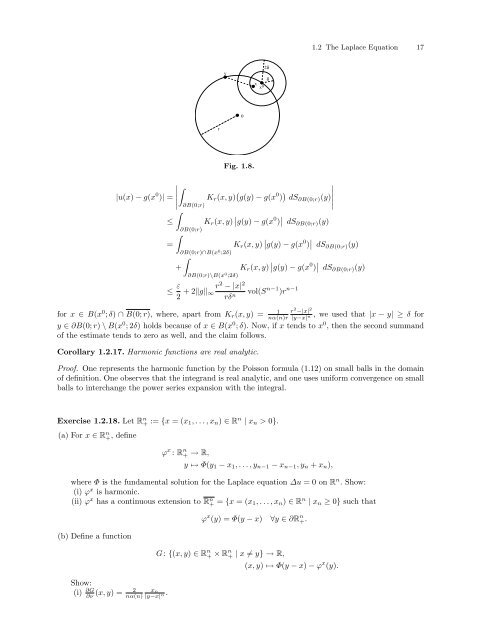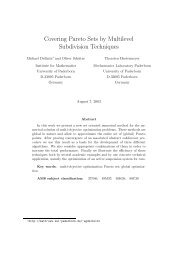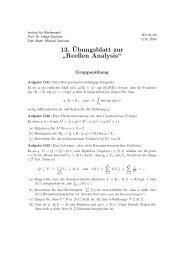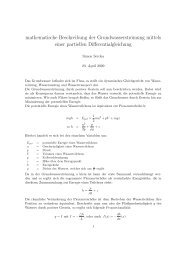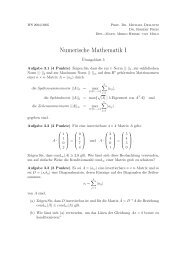Partial Differential Equations
Partial Differential Equations
Partial Differential Equations
You also want an ePaper? Increase the reach of your titles
YUMPU automatically turns print PDFs into web optimized ePapers that Google loves.
1.2 The Laplace Equation 17<br />
y<br />
2δ<br />
δ<br />
x x 0<br />
0<br />
r<br />
∫<br />
|u(x) − g(x 0 )| =<br />
∣<br />
∫<br />
≤<br />
∫<br />
=<br />
∂B(0;r)<br />
∂B(0;r)<br />
Fig. 1.8.<br />
K r (x, y) ( g(y) − g(x 0 ) ) dS ∂B(0;r) (y)<br />
∣<br />
K r (x, y) ∣ ∣ g(y) − g(x 0 ) ∣ ∣ dS∂B(0;r) (y)<br />
∂B(0;r)∩B(x 0 ;2δ)<br />
∫<br />
+<br />
∂B(0;r)\B(x 0 ;2δ)<br />
K r (x, y) ∣ ∣ g(y) − g(x 0 ) ∣ ∣ dS∂B(0;r) (y)<br />
≤ ε 2 + 2‖g‖ r 2 − |x| 2<br />
∞<br />
rδ n vol(S n−1 )r n−1<br />
K r (x, y) ∣ ∣ g(y) − g(x 0 ) ∣ ∣ dS∂B(0;r) (y)<br />
for x ∈ B(x 0 1 r<br />
; δ) ∩ B(0; r), where, apart from K r (x, y) = 2 −|x| 2<br />
nα(n)r |y−x|<br />
, we used that |x − y| ≥ δ for<br />
n<br />
y ∈ ∂B(0; r) \ B(x 0 ; 2δ) holds because of x ∈ B(x 0 ; δ). Now, if x tends to x 0 , then the second summand<br />
of the estimate tends to zero as well, and the claim follows.<br />
Corollary 1.2.17. Harmonic functions are real analytic.<br />
Proof. One represents the harmonic function by the Poisson formula (1.12) on small balls in the domain<br />
of definition. One observes that the integrand is real analytic, and one uses uniform convergence on small<br />
balls to interchange the power series expansion with the integral.<br />
Exercise 1.2.18. Let R n + := {x = (x 1 , . . . , x n ) ∈ R n | x n > 0}.<br />
(a) For x ∈ R n +, define<br />
ϕ x : R n + → R,<br />
y ↦→ Φ(y 1 − x 1 , . . . , y n−1 − x n−1 , y n + x n ),<br />
where Φ is the fundamental solution for the Laplace equation ∆u = 0 on R n . Show:<br />
(i) ϕ x is harmonic.<br />
(ii) ϕ x has a continuous extension to R n + = {x = (x 1 , . . . , x n ) ∈ R n | x n ≥ 0} such that<br />
(b) Define a function<br />
Show:<br />
2<br />
(x, y) =<br />
(i) ∂G<br />
∂ν<br />
x n<br />
nα(n) |y−x|<br />
. n<br />
ϕ x (y) = Φ(y − x) ∀y ∈ ∂R n +.<br />
G: {(x, y) ∈ R n + × R n + | x ≠ y} → R,<br />
(x, y) ↦→ Φ(y − x) − ϕ x (y).


